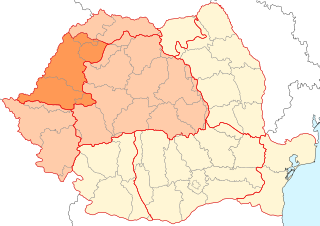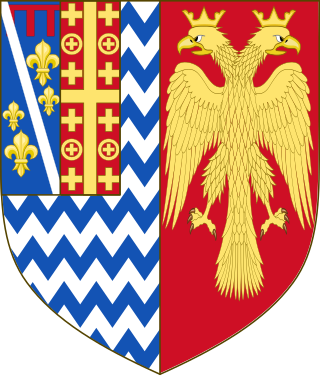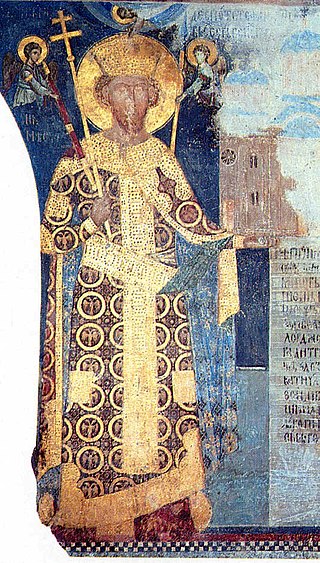
The Doge of Venice sometimes translated as Duke, was the chief magistrate and leader of the Republic of Venice between 726 and 1797.

Crișana is a geographical and historical region in north-western Romania, named after the Criș (Körös) River and its three tributaries: the Crișul Alb, Crișul Negru, and Crișul Repede. In Romania, the term is sometimes extended to include areas beyond the border, in Hungary; in this interpretation, the region is bounded to the east by the Apuseni Mountains, to the south by the Mureș River, to the north by the Someș River, and to the west by the Tisza River, the Romanian-Hungarian border cutting it in two. However, in Hungary, the area between the Tisza River and the Romanian border is usually known as Tiszántúl.

The Order of the Dragon was a monarchical chivalric order only for selected higher aristocracy and monarchs, founded in 1408 by Sigismund of Luxembourg, who was then King of Hungary and Croatia and later became Holy Roman Emperor. It was fashioned after the military orders of the Crusades, requiring its initiates to defend the cross and fight the enemies of Christianity, particularly the Ottoman Empire.
Grand prince or great prince is a title of nobility ranked in honour below Emperor, equal to Archduke, King, Grand duke and Prince-Archbishop; above a Sovereign Prince and Duke.

The despot of Epirus was the ruler of the Despotate of Epirus, one of the successor states of the Byzantine Empire in the aftermath of the Fourth Crusade. The name "Despotate of Epirus" and the title "despot of Epirus" are modern historiographical names, and were not in use by the despots themselves. In the Byzantine Empire, the title of despot was a prestigious court title and did not designate rule over some specific territory. Though several of the early Greek rulers of the Epirote realm did use the title of despot, it was never in reference to the lands they governed, but instead in reference to their position in the imperial hierarchy.

Stefan Lazarević, also known as Stefan the Tall, was a Serbian ruler as prince (1389-1402) and despot (1402-1427). He was also a diplomat, legislator, ktetor, patron of the arts, poet and one of the founding members of the Order of the Dragon. The son of Prince Lazar Hrebeljanović, he was regarded as one of the finest knights and military leaders at that time. After the death of his father at Kosovo (1389), he became ruler of Moravian Serbia and ruled with his mother Milica, until he reached adulthood in 1393. Stefan led troops in several battles as an Ottoman vassal, until asserting independence after receiving the title of despot from the Byzantines in 1402.

Đurađ Branković was the Serbian Despot from 1427 to 1456. He was one of the last Serbian medieval rulers. He was a participant in the battle of Ankara (1402) and Ottoman Interregnum (1403-1413). During his reign, the despotate was a vassal of both Ottoman sultans as well as Hungarian kings. Despot George was neutral during the Polish-Lithuanian (1444) and Hungarian-Wallachian (1448) crusades. In 1455, he was wounded and imprisoned during clashes with the Hungarians, after which the young Sultan Mehmed II launched the siege of Belgrade and its large Hungarian garrison. Despot Đurađ died at the end of 1456, due to complications stemming from the wound. After his death, Serbia, Bosnia and Albania became practically annexed by sultan Mehmed II, which only ended after centuries of additional conquests of Byzantine lands. Đurađ attained a large library of Serbian, Slavonic, Latin, and Greek manuscripts. He made his capital Smederevo a centre of Serbian culture. He was the first of the Branković dynasty to hold the Serbian monarchy.

Rascians was a historical term for Serbs. The term was derived from the Latinized name for the central Serbian region of Raška. In medieval and early modern Western sources, exonym Rascia was often used as a designation for Serbian lands in general, and consequently the term Rasciani became one of the most common designations for Serbs. Because of the increasing migratory concentration of Serbs in the southern Pannonian Plain, since the late 15th century, those regions also became referred to as Rascia, since they were largely inhabited by Rasciani (Rascians). Among those regions, term Rascia (Raška) was most frequently used for territories spanning from western Banat to central Slavonia, including the regions of Syrmia, Bačka, and southern Baranja. From the 16th to the 18th century, those regions were contested between the Ottoman Empire and the Habsburg monarchy, and today they belong to several modern countries.

Stefan Branković, also known in historiography as Stefan the Blind, was briefly the despot (ruler) of the Serbian Despotate between 1458 and 1459, member of the Branković dynasty.

Đurađ I Balšić, or Gjergj Balsha I was the Lord of Zeta between 1362 and 13 January 1378. He was the eldest of the three sons of Balša I, and belonged to the Balšić family.
Gjon Kastrioti was an Albanian feudal lord from the House of Kastrioti and the father of future Albanian leader Gjergj Kastrioti. He governed the territory between Shufada, the Cape of Rodon, Prizren and Dibër and had at his disposal an army of 2,000 horsemen.

Despot or despotes was a senior Byzantine court title that was bestowed on the sons or sons-in-law of reigning emperors, and initially denoted the heir-apparent of the Byzantine emperor.
Vladislav Hercegović was oldest son of Stjepan Vukčić. The Kosača noble family held lands in the region of Herzegovina. Vladislav received his father's land and the title of herzog. During his father's reign he is known to have interfered with his affairs. After 1453 he was frequently in the service of the Ottoman Empire, the Republic of Venice and the Hungarian-Croatian king Matthias Corvinus. Corvinus granted him the forts of Veliki Kalnik and Mali Kalnik near Križevci.

Between 1345 and 1371, the Serbian monarch was self-titled emperor (tsar). The full title was initially Emperor of the Serbs and Greeks, later Emperor of the Serbs, Greeks and Bulgarians in Serbian and basileus and autokrator of Serbia and Romania ["the land of the Romans"] in Greek. This title was soon enlarged into "Emperor and Autocrat of the Serbs and Greeks, the Bulgarians and Albanians". The Serbian Empire was ruled by only two monarchs; Stefan Dušan and Stefan Uroš V. Two other claimants of the title ruled in Thessaly, Central Greece.
The Serbian monarchs and royalty have assumed several regnal titles and styles throughout history.
The Albanian nobility was an elite hereditary ruling class in Albania, parts of the western Balkans and later in parts of the Ottoman world. The Albanian nobility was composed of landowners of vast areas, often in allegiance to states like the Byzantine Empire, various Serbian states, the Republic of Venice, the Ottoman Empire and the Kingdom of Naples in addition to the Albanian principalities. They often used Byzantine, Latin or Slavic titles, such as sebastokrator, despot, dux, conte and zupan.

The Banate of Macsó or the Banate of Mačva was an administrative division (banate) of the medieval Kingdom of Hungary, which was located in the present-day region of Mačva, in modern Serbia.
Vladislav Jonima was an Albanian nobleman that initially served Serbian King Stefan Milutin, holding areas of the Kingdom of Serbia in the region of Doclea and northern Albania. He was last mentioned in 1319, as a participant of a Catholic coalition of the Kingdom of Albania led by Philip of Taranto (r. 1294–1332, seemingly having switched sides against Milutin. He is an ancestor of the Jonima family.
Balša Hercegović was the titular "Duke of St. Sava", as son of Vladislav Hercegović, the Grand Duke of Bosnia, sprung from the marriage to Byzantine princess Anna Kantakouzene. Historian D. Lovrenović noted that it was possible that he was Jelena Nelipić's son. Some time after 1455, Vladislav sent Anna and Balša and his niece Mara to live in the Republic of Ragusa. Balša's brother was Petar. His father was given the estate of Kalnik near Križevci, Croatia in 1469 by Matthias Corvinus, where Balša seems to have retired.
John George Heracleus Basilicos was a mercenary and pretender, mainly active in Italy in the late 16th century and early 17th century. Heracleus claimed to be a descendant of the Roman emperor Heraclius and through a varying assortment of titles claimed to be the legitimate ruler of the Peloponnese, Macedonia, Moldavia, Wallachia and Albania. Until 1593, he also claimed to be the Grand Master of the Constantinian Order of Saint George, in opposition to the legitimate grand masters Andrea, Pietro and Giovanni Andrea I Angeli.
















